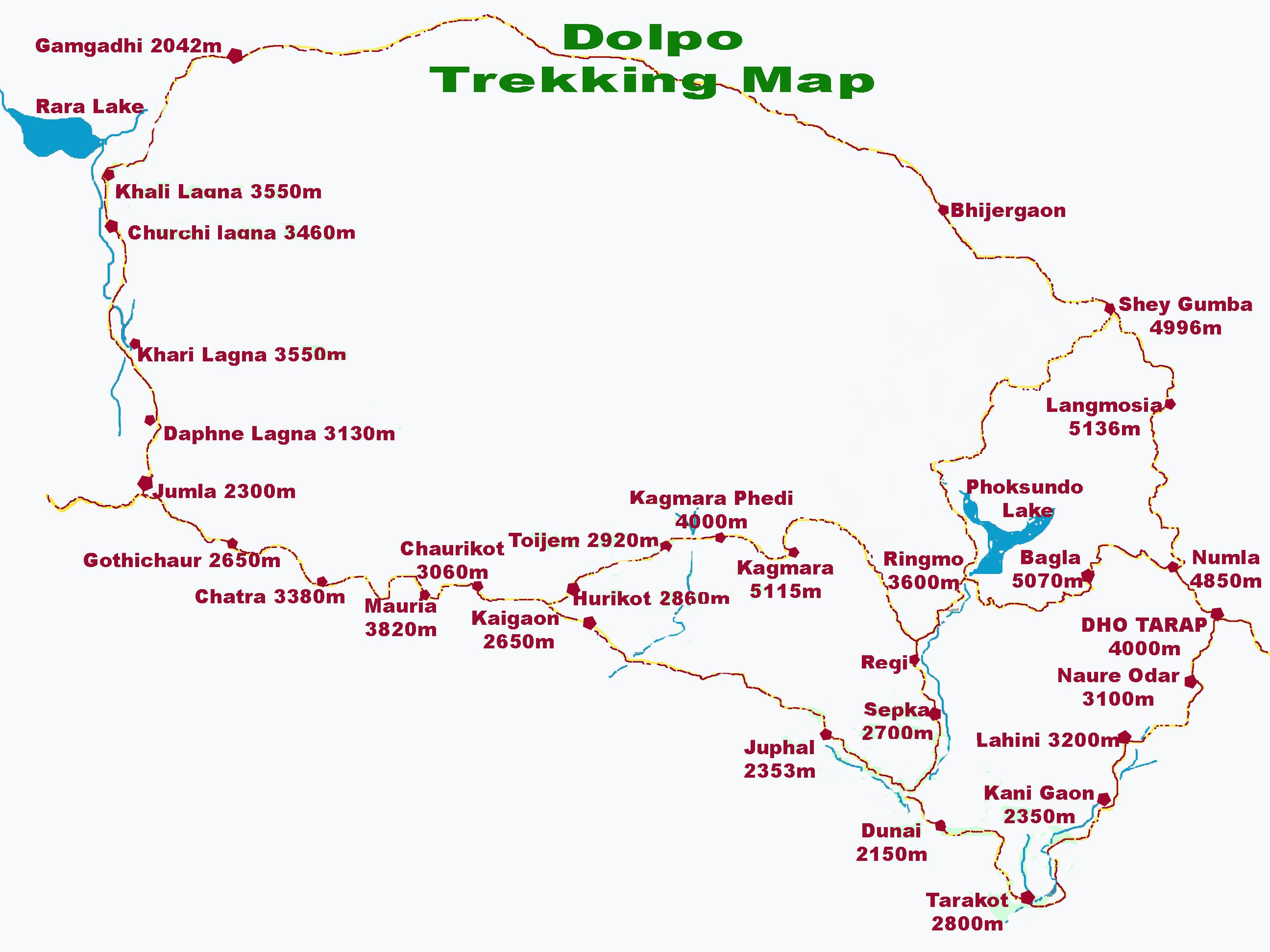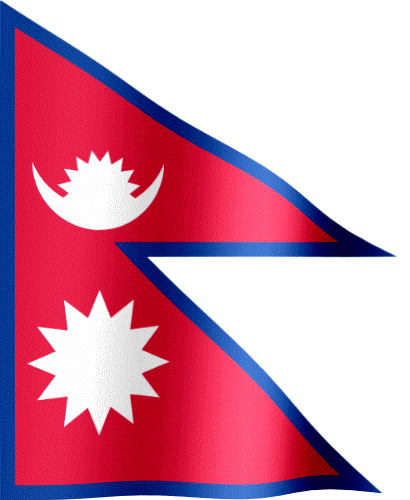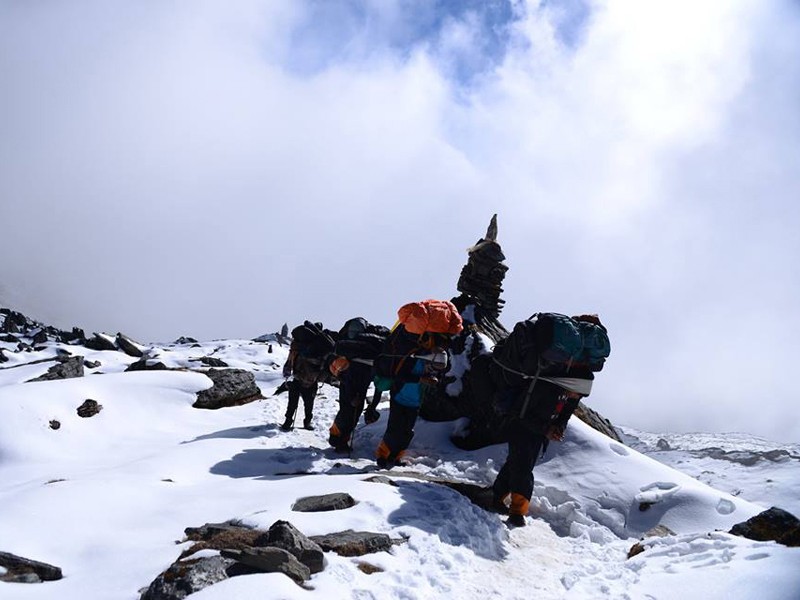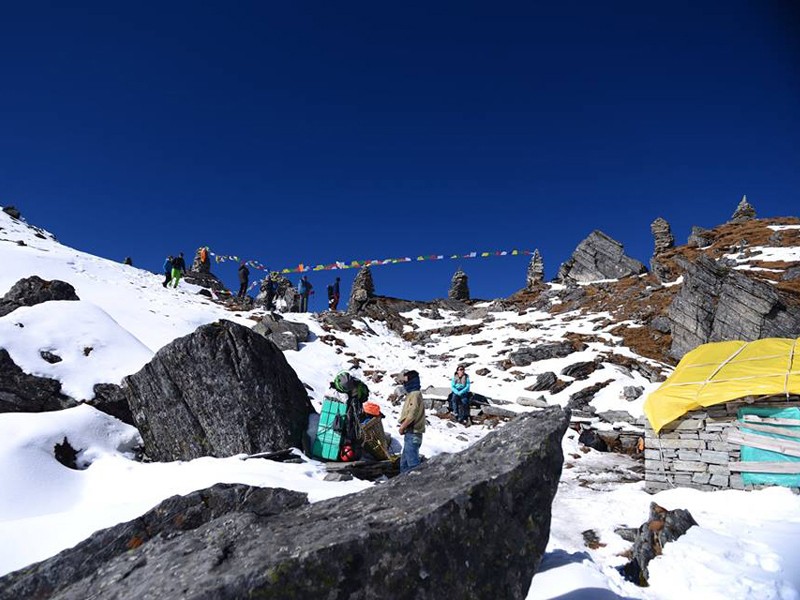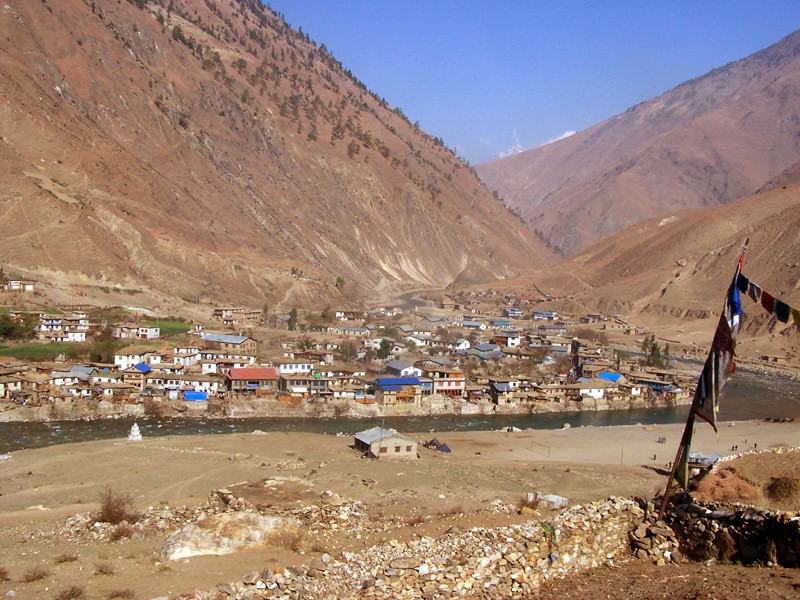Reference Code: IDT
Maximum Altitude: 5,190m
Season: Spring and Autumn
Accommodation: Camp
Destination: Nepal
Physical Rating: Strenuous
Group Size: 2-16
Theme: Trekking
Dolpa is also called 'Ba Yul' or the Hidden valley is a land of mystery, scenery and peace. Surrounded by Dhaulagiri and Tibet from south and north, The Dolpo region is the natural embodiment of high passes, rare flora and fauna and sweeping vistas. The medicinal plant, Yarchagumba (Coerdiopsis sinensis) a type of wild mushroom is found in abundance in this region. Extracts from Yarchagumba is believed to significantly improve health and fitness. This trekking is for combination of natural and cultural phenomena which is enriched by the traditional Tibetan cultural heritage. It is a rain shadow area and was opened in 1991 for trekking. The whole trekking areas in this region stretches through and around Arun River whose origin dates back to prehistoric period. The Arun valley is one of the most beautiful regions to trek in Nepal. Dolpo is protected by Shey-Phoksundo National Park. It lies to the north of the Dhaulagiri Range bordering the Tibetan Plateau. Here one can find a well-preserved eco-system of plants and wildlife, including the blue sheep and the elusive snow leopard. The view of Kanjiroba peak, Phoksumdo Lake, and the Dhauligiri massif is one of the most rewarding moments of this trek. A visit to the Phoksumdo Gompa 1½ dedicated to the ancient Bonpo religion, local to Dolpo and Tibet, is a memorable experience.
Day 01 Arrival in Kathmandu (1350m.)
Namaste! And welcome to Kathmandu, the colourful capital of Nepal where ornately carved balconies mingle with beautiful shrines and temples. Your adventure begins with a welcome meeting on arrival at the exit gate of Kathmandu airport. Our staff will welcome you and pick you to your accommodated hotel. Please seek our company palmplate to find our staff at the main exit gate of the airport. Rest of the day you can relax at the hotel or short evening walk around local market on your own as per your wish.
Day 02 Rest and preparation day
A well deserved rest day at cosy of hotel after a long tiring flight. This day, one can move around nearby local market to purchase or hire trekking equipment that is necessary for the trekking like sleeping bags, walking sticks etc, exchange currency as requirement or simply walk around in the local market or Kathmandu Durbar squire nearby with small entrance fee as per your preference on your own. Evening at the hotel lobby there will be pre-trip briefing in which you will be introduced with your trekking guide and explained about your trip in short, instruction for safety etc.
Day 03 Fly to Nepalgunj
Take an early morning flight to Nepalgunj from Kathmandu. Nepalgunj lies in the Terai region of Nepal where you can experience the change in topography and temperature. Upon arrival, feel free to enjoy and explore the place.
Day 04 Flight to Juphal and trek to Sulighat(2050m.)
Early morning flight from Nepalgunj takes us to Juphal in about 40 minutes. In Juphal, we meet other members of our team and make final preparation for the trek ahead by assigning the baggage to our porters. We then descend alongside ThuliBheri River and make our way to Sulighat.
Day 05 Trek to Chhepka(2970m.)
The Suli River descends from Phoksundo Lake through a sheer and highly vegetated gorge. The trail goes through disseminated villages and abandoned crude stone houses of Jyalhasa. Many of these villages are only full during the winter months when the groups of Upper Dolpo bring their animals down from the high meadows. After lunch, we pass AnkeKhola and ascend alongside Suli River to reach our campsite in Chhepka.
Day 06 Trek to Samduwa(3085m.) via Renje Village
We cross and ascend the narrow valley through forests of bamboo and conifer. At one point, the trail ascends to the jungle and into flower-strewn fields. Finally, the gorge opens up and the trail becomes easier until we cross a bridge to Rechi. Beyond here, the valley contracts once again and the trail ascends and descends till the union of Phoksundo River and Pungmo River. Samduwa is situated right above the confluence.
Day 07 Trek to Ringmo
Today's destination is the village of Ringmo, situated by the side of the attractive Phoksundo Lake. Keeping to the left side of Phoksundo River, incline for some time to reach a large waterfall. Then follow a pleasant trail along the Phoksundo River to a green clearing spot for lunch. The afternoon's walk up to Ringmo is very satisfying as enormous rock walls guard the upper valley and as we arrive in Ringmo village, the lake can be seen
Day 08 Exploration day
Today will be a hard-earned rest day for acclimatization at Phoksundo Lake. We have the whole day to relish the beauty and calmness of the turquoise lake. During the day, we can take on a short hike to the village of Ringmo and its monastery. Our short walk also allows us an opportunity to get aware with the local culture. The Dolpo people wear simple clothing that is sometimes dyed a maroon tint, and they prefer Tibetan-style somba or dhocha (boots with upturned toes) for footwear. Both men and women often wear religious charms and cords of coral, amber, and turquoise.
Day 09 Trek to North Ridge Camp
oday we start to walk to PhoksundoKhola Camp with a remarkable track around the western end of the lake. The trail goes mostly through the riverbed of PhoksundoKhola and features a remarkable view of KanjirowaHimal (6612m). As we reach the camp, we notice the sparkling pure turquoise water of Phoksundo Lake lying right below.
Day 10 Trek to Kang La Base camp
We exit Phoksundo valley on a narrow path with high rock walls on both edges. It is a short ascend from PhoksundoKhola Camp to Snowfields Camp, but due to the steep paths, we need to maintain a gradual pace so that we don’t tire ourselves.
Day 11 Trek to Shey Gompa (4370m.)
Ascend for a few hours to reach the summit of Kang La (5350m). This high pass that leads us into Inner Dolpo is also known as the Nagadalo La. Descend to the valley floor and move along the river to reach SheyGompa. The monastery is situated under the peculiar Crystal Peak on a small green plain created by the convergence of two rivers. We set up our camp just underneath the gompa in a field containing a few herders’ huts.
Day 12 Exploration day
We rest and explore the SheyGompa vicinity today. SheyGompa was built in 1655 and the monastery is renowned for its giant copper with the gold-plated gold statue of a seated Sakyamuni Buddha. To the east of the Gompa is Crystal Mountain with its twisted cliffs that are mixed with quartz and embedded with a rich variety of aquatic fossils. We also explore Shey village and familiarize ourselves with its olden pre-Buddhist culture, the Bon Po.
Day 14 Trek to Namgung(4415m.) Via crossing Gela La
To get to Namgung, we have to move through the pass Gela La (5094m), which is also known as Gela La. From the top of the pass, we can get an amazing view of Inner Dolpo as well as the Tibetan plateau. Afterward, descend along the meadows to reach Namgung village, where we can visit the ancient Namgung Gompa.
Day 15 Trek to Saldang(4070m.)
The trek to Saldang goes through a quiet path on a rocky trail. We descend relishing the unique landscape made up of tall sand hills. The soothing trails take us to the beautiful village of Saldang, which in ancient times used to be an independent kingdom of Dolpo. We can stroll around the village later in the evening.
Day 16 Trek to Sibu.
After leaving Saldang, we move along NagonKhola through attached fields of barley, the main crop of Dolpo. We cross the dispersed village of Namdo which has two monasteries, one beside the stream and another high on a hilltop. Our waterside camp tonight is near the smaller village of Sibu.
Day 17 Trek to Chang La Base Camp
From Sibu, we follow NagonKhola for a while and pass by many yak caravans as we head towards Chang La. The bare rocky hills and the sand dunes keep us company as we ascend alongside DachunKhola to finally reach a yak grazing area where Chang La Phedi is situated.
Day 18 Trek to Tok Kyu(4160m.) crossing Chang La(5220m.)
From Chang La Phedi, it is a sheer ascend to Chang La (5220m) which is reached after a few hours. From the top, we get a distant view of several peaks of the Dhaulagiri massif. Beyond the pass, we go downhill to reach JyanlaKhola and follow it until reaching Tok Kyu village.
Day 19 Trek to Do (4020m.)
The Tarap valley is our destination today as we descend along various Gompas situated on the bank of Thakchiu Khola. A gentle walk alongside the river takes us to DhoTarap, the first village in the Tarap valley. After resting for a while, we explore the village and visit the monastery there.
Day 20 Contingency Day
This is a free day in case we have met any problems with our trekking timetable. If we haven't had to use this day, we have the choice to spend a rest day in DhoTarap or at one of the campsites lower down in the valley. Our trip leader will choose the most suitable place to take this rest day.
Day 21 Trek to Sim Ora(3647m.)
Moving downhill beside the river, we continue trekking below striking cliffs, before the ridge which is noticeable with its two ancient Chortens. Moving down to the meadows of the SisaulKhola, we cross Tarap Chu on different bridges to reach the grazing area of Shim Ora (3647m).
Day 22 Trek to Kanigaon (2620m.)
Today we walk through the valley of Tarap Chu on a well-engineered track, including some stone ladders. The trail then goes down to Kanigaon. We make camp just outside the settlement, below the check post, in a stand of juniper beside the stream. We are now at a lower elevation and it is pleasantly warm.
Day 23 Trek to Tarakot
As we leave Kanigaon, we come to a union of Tarap Chu and BharbungKhola, and shortly after, we move along the high suspension bridge. The trail ascends above the river until a final descend to Tarakot alongside ThuliBheri River. This is a short day of trekking, so after lunch, we ascend to the impressive Lam Gompa.
Day 24 Trek to Dunai(2090m.)
We almost complete our journey as we move alongside ThuliBheri River to reach Dunai. The trail is dotted with many scattered settlements along with their farms. An easy and short walk through the picturesque trail brings us to Dunai, which is the district headquarters of Dolpo with a few lodges and restaurants where we can celebrate the completion of our trek together.
Day 25 Trek to Juphal
Today is the last day of the trek which goes mostly along the banks of ThuliBheri River to take us to the airstrip in Juphal from the headquarters. We can explore the town in our free time as we only trek for a few hours today.
Day 26 Fly to Nepalgunj and to Kathmandu
We take the first flight from Juphal to Nepalgunj enjoying the scenic view. We then take another flight from Nepalgunj to reach Kathmandu. Upon arrival in Kathmandu, you will be taken to your hotel. Feel free to enjoy the nightlife of Kathmandu.
Day 27 Rest and final shopping day
This is the final day in Nepal. A chance to do some shopping, explore at leisure or merely relax by the hotel. We enjoy a final night together, reliving the trek and our extraordinary achievements.
Day 28 Final departure
We say 'Namaste' for memories that will last a lifetime. There are no activities planned for today and you are able to depart the hotel at any time. Check out time from the hotel is at 12 noon. If you are departing later, you can arrange luggage storage at the hotel. For your final departure, our staff will pick you up from the hotel and transfer to Kathmandu airport approximately 3 hours prior to your international flight time.
Inclusion
- All necessary ground transportation as required by itinerary.
- 5 night hotel accommodation in Kathmandu
- 1/2 day sight seeing as per itinerary
- 1 night hotel accommodation in Nepalgunj
- Domestic flight: KTM-NPJ-JUM-NPJ-KTM with airport tax
- TIMs(Trekking Information Management System) Card
- Special Restricted Area permit
- National Park fee
- Standard Camping food
- All necessary camping equipment with kitchen utensils and kerosene
- All necessary camping charges
-
Medical supplies(First aid Kit will be available)
-
All required Nepalese staffs (salary, food, clothing, accommodation)
-
All Nepalese staffs insurance as per Nepalese Government rules
- Company Service charge, VAT and government taxes
Exclusion
- International flight with airport tax.
- Nepalese Entry Visa fee
- Food during stay in Kathmandu and Nepalgunj
- All personal equipment and personal expenses
- Photography Charges, Monument charges and Monument entry fees
- Personal Medical and travel insurance(must cover helicopter rescue evacuation cost)
- Personal Medicine
- Telephone and internet charges
- Laundry charges
- Alcoholic beverage, bottled drinks and cold drinks during the trip
- Rescue evacuation charges if required
- Staff and porters Tips...
Equipment List
Clothing and Equipments List
» Pack to pack out - bring enough waterproof bags to carry all non-biodegradable rubbish back down the mountain.
» Remove all unnecessary packaging before leaving home.
» Bring enough warm dry clothes so that you can wrap up rather than burn firewood in the evenings.
» If you are going to trek higher than 5000m or you know it will be cold, buy an aluminum water bottle which can also be used as a hot water bottle at night.
» The easiest way to keep hydrated while trekking is to buy a 1 x liter platypus-drinking bladder to carry in your day pack.
» Make sure to buy proper trekking socks. Don’t buy synthetic socks as these promote sweating and can give you blisters. Always carry a few blister pads in your first aid kit and keep them handy in your day pack.
» Walking poles are very useful while trekking and helpful when descending.
» Please remember that waste disposal and recycling facilitates are limited in Nepal. When buying batteries make sure they are rechargeable and/or high quality so they last longer, and take them home to recycle.
More Lists
There is no definitive list. What you bring will vary according to the area, time of year and the length of your trek. Below is a suggested check list which you should adapt to your own needs. Ask yourself: Will there be snow/how long /high is the trek/are we camping?
» Good quality trekking boots with ankle support
» Lightweight shell/raincoat with hood
» Detachable fleece liner or separate fleece
» Fleece trousers
» Shorts and / or convertibles trousers- quick drying
» Sunglasses
» Sun hat and warm hat(good quality)
» Gloves
» Spare T-shirt x 3
» Sweat towel x 2
» Spare socks x 3 ( walking sock and thin inner sock)
» Small day sack
» Sun cream
» Small water bottle aluminum doubles as a hot water bottle.
» Iodine or water purifying kit,
» Soluble vitamin tablets to taste water or powder fruit drink
» Talcum powder
» Walking sticks or Trekking poles(good quality)
» Camp shoes/trainers/flip flops to wear in evening.
» Spare underwear 3
» Toilet kit
» Tissues
» Pen knife
» Bum bag
» Head torch(good quality)
» Biodegradable washing liquid / soap
» FILM
» CAMERA
» Ear plugs
» Sleeping bag liner(good quality)
» Sleeping bag(good quality-30)
» Bin bag/ gasbag to keep kit dry
» Small towel
» Lip balm
» Available in KTM
Personal First Aid (Aids Kit)
» Antiseptic
» Bandages
» Blister plasters
» Decongestant
» AMS medication like Diamox
» Eye drops – it can get very dusty on trails
» Paracetamol and/or ibuprofen
» Rehydration sachets, Imodium and antibiotics for traveler’s diarrhea
» Scissors
» Sterile dressing
» Sticking plasters and tape
» Throat lozenges / sweets
» Tweezers
» A sewing needle etc.
This trekking equipment list has been prepared by Adventure Zambuling Treks (P) Ltd.
22nd July 2022/23
